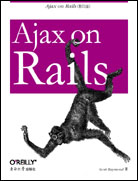
Ajax on Rails(影印版)
出版时间:2007年06月
页数:352
《Ajax on Rails》将向您讲解如何使用两种当今最重要的方法来构建与用户互动
的动态网络应用程序,这两种方法就是Ajax和开发效率很高的Ruby on Rails平
台。
本书向您展示如何同时使用Ajax和Rails来快速构建性能高、扩展性良好的应用程
序,并且不必去写大量难以维护的JavaScript代码。本书在叙述底层细节以便让您
理解表面现象下的原理的同时,也给出一张全景图帮助您高效地使用Ajax技术。
书中的主题涵盖了以下内容:
*从XMLHttpRequest技术的角度重新看待客户机-服务器模式,并讲述其他Ajax基
础知识
*使用Prototype和script.aculo.us库程序来简化您的代码,在消除对特定浏览器
的依赖性的同时生成出色的视觉效果
*使用RJS在您的Ruby模板中自动生成JavaScript,进一步简化您的Ajax程序开发
*使用一切手段来调试Ajax应用程序,包括查看标准的日志文件、使用Ruby终端
(console)、安装Routing Navigator插件以及使用Firefox浏览器的Firebug扩展
应用程序(extension)
*为Ajax应用程序开发功能测试与集成测试;使用ARTS测试RJS;对您的
JavaScript进行单元测试
*地道好用的编译程序以及其他可以提高Ajax易用性的设计技巧
*通过介绍针对Ajax的常用网络攻击手法以及对应的防范方法,讲解如何构建安全
的网络应用程序
*快速应用程序构建技巧,包括选择会话存储(session store)、使用缓存
(caches)来提高性能,对静态文件打包以便浏览器不把时间浪费在下载很多的文
件上面,还有使用Ajax与BackgroundDRb来提供快速反应接口——甚至是为长时间
运行的任务
《Ajax on Rails》包括对Prototype 1.5和script.aculo.us 1.6.1的全面参考,
这些内容对于不使用Rails平台进行开发的网络应用程序也非常有参考价值。同时
本书还提供3个完整的网络应用程序范例,分别是在线考试程序、在线图片浏览器
和工作组协同程序。这些例子向您说明了在实际应用中如何把相关的技术组合起来
以满足软件开发需求。
Ruby on Rails和Ajax都给网络开发带来了革命性的变化,但它们走的是不同的路
线。《Ajax on Rails》向您展示了如何把这两项技术结合起来。如果您已经厌倦
了那些普通单调的开发方式,想走出网络应用程序开发的“下一步”的话,那么,
本书给您指明了方向。
Scott Raymond是一位住在美国堪萨斯城(Kansas City)的Ruby on Rails开发人
员。他的作品已经被on the Rails网站和华尔街日报网络版高度评价。除了参与
Ruby on Rails的框架开发之外,他还领导了国际Rails课程培训并作为RailsConf
2006的大会发言人进行演讲。
的动态网络应用程序,这两种方法就是Ajax和开发效率很高的Ruby on Rails平
台。
本书向您展示如何同时使用Ajax和Rails来快速构建性能高、扩展性良好的应用程
序,并且不必去写大量难以维护的JavaScript代码。本书在叙述底层细节以便让您
理解表面现象下的原理的同时,也给出一张全景图帮助您高效地使用Ajax技术。
书中的主题涵盖了以下内容:
*从XMLHttpRequest技术的角度重新看待客户机-服务器模式,并讲述其他Ajax基
础知识
*使用Prototype和script.aculo.us库程序来简化您的代码,在消除对特定浏览器
的依赖性的同时生成出色的视觉效果
*使用RJS在您的Ruby模板中自动生成JavaScript,进一步简化您的Ajax程序开发
*使用一切手段来调试Ajax应用程序,包括查看标准的日志文件、使用Ruby终端
(console)、安装Routing Navigator插件以及使用Firefox浏览器的Firebug扩展
应用程序(extension)
*为Ajax应用程序开发功能测试与集成测试;使用ARTS测试RJS;对您的
JavaScript进行单元测试
*地道好用的编译程序以及其他可以提高Ajax易用性的设计技巧
*通过介绍针对Ajax的常用网络攻击手法以及对应的防范方法,讲解如何构建安全
的网络应用程序
*快速应用程序构建技巧,包括选择会话存储(session store)、使用缓存
(caches)来提高性能,对静态文件打包以便浏览器不把时间浪费在下载很多的文
件上面,还有使用Ajax与BackgroundDRb来提供快速反应接口——甚至是为长时间
运行的任务
《Ajax on Rails》包括对Prototype 1.5和script.aculo.us 1.6.1的全面参考,
这些内容对于不使用Rails平台进行开发的网络应用程序也非常有参考价值。同时
本书还提供3个完整的网络应用程序范例,分别是在线考试程序、在线图片浏览器
和工作组协同程序。这些例子向您说明了在实际应用中如何把相关的技术组合起来
以满足软件开发需求。
Ruby on Rails和Ajax都给网络开发带来了革命性的变化,但它们走的是不同的路
线。《Ajax on Rails》向您展示了如何把这两项技术结合起来。如果您已经厌倦
了那些普通单调的开发方式,想走出网络应用程序开发的“下一步”的话,那么,
本书给您指明了方向。
Scott Raymond是一位住在美国堪萨斯城(Kansas City)的Ruby on Rails开发人
员。他的作品已经被on the Rails网站和华尔街日报网络版高度评价。除了参与
Ruby on Rails的框架开发之外,他还领导了国际Rails课程培训并作为RailsConf
2006的大会发言人进行演讲。
- Preface
- 1. Introduction
- Who This Book Is For
- What Ajax Is
- What Rails Is
- 'You Got Your Ajax in My Rails!'
- Getting Up to Speed
- Summary
- 2. Getting Our Feet Wet
- The Old-Fashioned Way
- JavaScript Libraries and Prototype
- Bringing Rails into the Picture
- Summary
- 3. Introducing Prototype
- Setting the Stage
- Ajax Links
- Forms
- Ajax Forms
- Buttons
- Form Observers
- Summary
- 4. Introducing script.aculo.us
- Visual Effects
- Drag and Drop
- Summary
- 5. RJS
- Instructions Instead of Data
- Putting the R in RJS
- A Real-World Example
- Summary
- 6. Ajax Usability
- Principles of Usability
- The Context of the Web
- Usability on the Web
- Cross-Platform Development
- Summary
- 7. Testing and Debugging
- Debugging
- Testing
- Summary
- 8. Security
- Healthy Skepticism: Don't Trust User Input
- Hashing Passwords
- Silencing Logs
- The Same-Origin Policy
- The Use and Abuse of HTTP Methods
- Encryption and Secure Certificates
- The Rails Security Mailing List
- Summary
- 9. Performance
- Development and Production Environments
- Session Stores
- Output Caching
- Asset Packaging
- Dealing with Long-Running Tasks
- Summary
- 10. Prototype Reference
- Ajax Support
- DOM Manipulation
- Core Extensions
- 11. script.aculo.us Reference
- Visual Effects
- Drag and Drop
- Controls
- Element Extensions
- DOM Builder
- JavaScript Unit Testing
- Utility Methods
- Appendix A: Review Quiz
- Appendix B: Photo Gallery
- Appendix C: Intranet Workgroup Collaboration
- Index
书名:Ajax on Rails(影印版)
作者:Scott Raymond 著
国内出版社:东南大学出版社
出版时间:2007年06月
页数:352
书号:978-7-5641-0745-1
原版书出版商:O'Reilly Media
The animal on the cover of Ajax on Rails is a Peruvian spider monkey (Ateles
chamek), also known as a black-faced spider monkey. Native to the tropical forests
of Peru, Bolivia, and Brazil, this spider monkey weighs about 15 pounds (6.8 kg) and
lives 30 to 40 years. The black-faced spider monkey's body, arms, and legs each
measure about 20 inches, but its prehensile tail can be as long as 30 inches. The
prehensile tail acts as an extra hand and can support the weight of the monkey when
it needs to pick fruit with two hands or swing from tree to tree. The tail has a section
of fleshy pads that it uses for grasping and feeling, which is crucial since spider
monkeys are one of the only primates that do not have opposable thumbs; biologists
believe the thumb impeded the spider monkey's ability to swing from branch to
branch and was evolutionarily eliminated. The spider monkey's diet is 80 percent
fruit, but depending on the season it also eats insects, leaves, and seeds. Even though
the black-faced spider monkey is fairly common, deforestation has shrunk its livable
habitat, and it is often a target for hunters as well as pet traders.
chamek), also known as a black-faced spider monkey. Native to the tropical forests
of Peru, Bolivia, and Brazil, this spider monkey weighs about 15 pounds (6.8 kg) and
lives 30 to 40 years. The black-faced spider monkey's body, arms, and legs each
measure about 20 inches, but its prehensile tail can be as long as 30 inches. The
prehensile tail acts as an extra hand and can support the weight of the monkey when
it needs to pick fruit with two hands or swing from tree to tree. The tail has a section
of fleshy pads that it uses for grasping and feeling, which is crucial since spider
monkeys are one of the only primates that do not have opposable thumbs; biologists
believe the thumb impeded the spider monkey's ability to swing from branch to
branch and was evolutionarily eliminated. The spider monkey's diet is 80 percent
fruit, but depending on the season it also eats insects, leaves, and seeds. Even though
the black-faced spider monkey is fairly common, deforestation has shrunk its livable
habitat, and it is often a target for hunters as well as pet traders.
购买选项